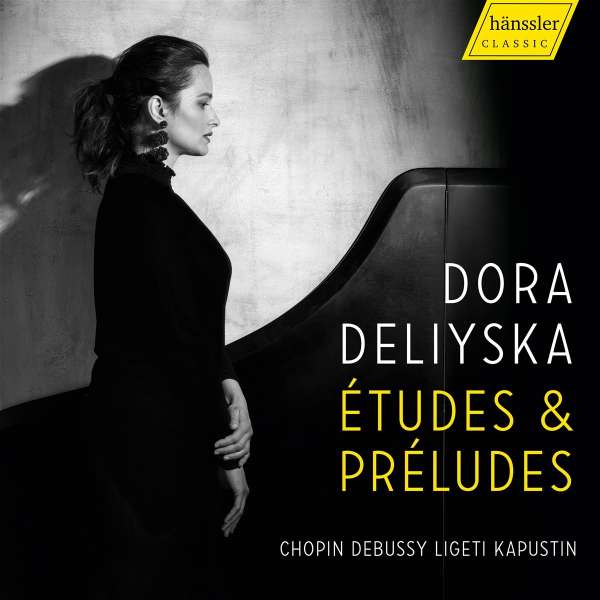Études & Préludes
CD

Description
It is remarkable how much and how often composers refer to each other and what connections one can discover as an interpreter between the individual works. In order to take a closer look at these connections, I have focused on two genres in creating the program, namely the etudes and preludes of Frédéric Chopin, Claude Debussy, György Ligeti and Nikolai Kapustin, hence the title “Études & Préludes”. I highlight various compositional methods and how they have evolved over time. Some of the works played are virtuosic or impressionistic, others poetic or jazzy.
All four composers are closely related to each other. The first part of the program consists of twelve selected etudes by Frédéric Chopin, Claude Debussy and György Ligeti. The pieces are arranged by intervals – from a repeated note (Ligeti calls this a “continuum,” whereas I refer to it as a “zero” interval) to a semitone step (“Pour les Degrés chromatiques” by Debussy), on to whole tone step, third, fourth, fifth, sixth, seventh to octave – developing an inner musical tension. At the end, one hears the etude “Pour les accords” by Claude Debussy, in which the chords can be perceived as a combination of intervals. The two arpeggio etudes before it (one by Chopin and one by Debussy) are considered examples of decomposed intervals that form strong harmonic nuances and colors.
The second part of the program consists of three composer blocks – 5 preludes by Chopin, 4 preludes by Debussy and 3 preludes by Kapustin. Thus, the listeners will be able to see the clear differences in style even more clearly. These twelve preludes of the second part mirror the first part and bring about a unity of the concert program, which with its 24 individual pieces can be regarded as an individual piano cycle and a separate piece of art.
– Dora Deliyska
Program
12 selected etudes from the cycles:
Frédéric Chopin, „Ètudes”, op. 25
Claude Debussy, 12 Etudes
György Ligeti, „Etüden“
1. György Ligeti, Etude No. 10, “Der Zauberlehrling” (The Sorcerer’s Apprentice)
2. Claude Debussy, Etude No. 7, „Pour les Degrés chromatiques“
3. Frédéric Chopin, Etude No .11, op. 25
4. György Ligeti, Etude No. 4, “Fanfares”
5. Frédéric Chopin, Etude No. 7, op. 25
6. György Ligeti, Etude No. 2, “Cordes á vide”
7. Frédéric Chopin, Etude No. 8, op. 25
8. György Ligeti, Etude No. 13, “L’escalier du diable”
9. Frédéric Chopin, Etude No. 10, op. 25
10. Claude Debussy, Etude No. 11, “Pour les Arpéges composés”
11. Frédéric Chopin, Etude No. 1, op.25
12. Claude Debussy, Etude No. 12, “Pour les Accords”
Break
12 selected preludes from the cycles:
Frédéric Chopin, 24 Préludes, op. 28
Claude Debussy, 24 Préludes, „Premier Livre“ und „Deuxième Livre“
Nikolai Kapustin, 24 Jazz preludes
1. Frédéric Chopin, Prelude No. 15, op. 28 in Des major, Sostenuto
2. Frédéric Chopin, Prelude No. 7, op. 28 in A major, Andantino
3. Frédéric Chopin, Prelude No. 8, op. 28 in f-sharp minor, Molto agitato
4. Frédéric Chopin, Prelude No. 13, op. 28 in Fis major, Lento
5. Frédéric Chopin, Prelude No. 16, op. 28 in b minor, Presto confuoco
6. Claude Debussy, Prelude No. 6, Band 2, “Des Pas sur la neige“, Triste et lent
7. Claude Debussy, Prelude No .6, Band 1, “General Lavine“ – excentric, Dans le style et el Mouvement dùn Cake-Walk
8. Claude Debussy, Prelude No. 3, Band 2, “La puerta del Vino“, Mouvt de Habanera
9. Claude Debussy, Prelude No. 7, Band 1, “Ce qu’a vu le vent d’ouest“, Anime et tumultueux
10. Nikolai Kapustin, Prelude No. 12 in g-sharp minor, “Allegretto“
11. Nikolai Kapustin, Prelude No. 11 in H major “Andante“
12. Nikolai Kapustin, Prelude No. 6 in h minor “Animato“


